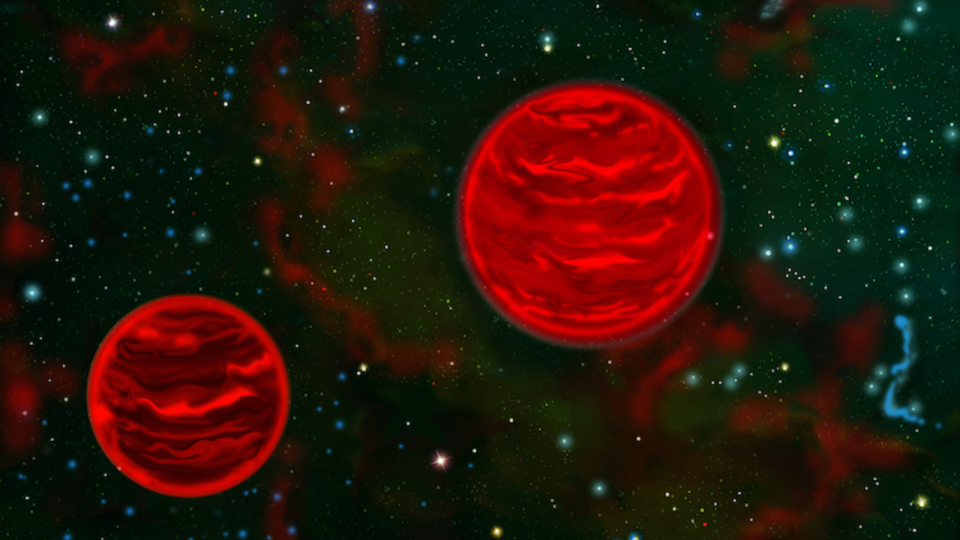At the end of 2023, astronomers made a startling discovery in the Orion Nebula. Using the James Webb Space Telescope (JWST), the team found 40 pairs of planetary mass objects — none of which orbit a star. They’re called Jupiter-Mass Binary Objects, or JuMBOs.
In short, this discovery directly challenged both star birth and planet formation theories. The origins of these orbs remained unknown, and it was unclear how such a large collection of pairs of these bodies came to wander the Orion stellar nursery, which is located around 1,350 light-years from Earth.
Now, however, a team of astrophysicists from the University of Nevada and Stoneybrook University think they may have solved the puzzle. The team provides a compelling model to explain how these strange bodies could have been ejected from their home systems, going rogue while still remaining paired with a binary partner. The findings, if correct, could revolutionize our picture of planetary evolution.
Related: Radio signals from Orion nebula reveal new data about strange celestial objects: ‘JuMBOS’
“Our simulations demonstrate that close stellar encounters can spontaneously eject pairs of giant planets from their native systems, leading them to orbit each other in space,” Nevada Center for Astrophysics postdoctoral fellow Yihan Wang said in a statement. “These findings could significantly alter our perception of planetary dynamics and the diversity of planetary systems in our universe.”
A JuMBO challenge
JuMBOs have been a challenge to explain because their existence doesn’t quite conform to classically accepted models of star formation or planet formation.
As hot, gassy and binary bodies, JuMBOs may initially seem as if they form when overly dense regions in a clouds of gas and dust collapse. That’s how stars form, and is even the mechanism followed by so-called “failed stars,” or brown dwarfs, which get their nickname from the fact they fail to gather enough mass to fuse hydrogen to helium in their cores — a defining stellar characteristic.
However, JuMBOS likely take a different route into reality. The chance of a star possessing a binary partner, for instance, diminishes significantly as the masses of those stars decreases. For example, around 75% of massive stars exist in binary pairings, but only 50% of stars with masses similar to the sun are found with a stellar partner. And the chance of finding a brown dwarf, with masses around 0.75 times that of the sun, in a binary is vanishingly small, approaching zero percent.
Brown dwarfs, on average, have masses around 75 times that of Jupiter. Thus, stars less massive than this, one can reason, should never exist in binaries — certainly not frequently enough to find 40 in the same nebula. JuMBOs have masses under the lower end of brown dwarfs, less than 13 times the mass of Jupiter. So, what’s going on?


Furthermore, JuMBOs can’t be explained with standard planetary formation models either. These are models that would see them born from leftover gas around a parent star, or stars if you’re working with a binary system. That is because, though we know planets are regularly kicked from their home systems to become rogue planets, aka cosmic orphans wandering the cosmos without a parent star, this process should be so violent that it’d splits apart any possible gravitationally bound planets.
The fact astronomers found 40 pairs of JuMBOs in the Orion Nebula alone therefore seems to rule out some freak ejection event that led to a planetary pair being ejected together without being split up.
So, to solve the mystery of where JuMBOS could possibly come from, the team performed advanced supercomputer simulations of ejection events. These “N-body” simulations allowed them to explore interactions in densely packed clusters of stars that could mean massive planets are ejected but remain gravitationally bound to each other. The conclusion was that JuMBOs could come from densely populated stellar clusters. If this is the case, then these strangely free-floating binaries could actually be quite common.
The team’s results have ramifications for our understanding of planet formation in general, indicating that characteristics such as orbital separation between planetary bodies in a JuMBO pairing as well as the shape of that orbit could affect the turbulent environmental conditions influencing planetary birth.
“It introduces dynamic stellar interactions as an important factor in the development of unusual planetary systems in dense stellar environments,” Rosalba Perna, team member and Stony Brook University professor of physics, said in the statement.
RELATED STORIES:
— Star blows giant exoplanet’s atmosphere away, leaving massive tail in its wake
—Surprise! Baby exoplanets might look like Smarties candies rather than spheres
— James Webb Space Telescope glimpses Earendel, the most distant star known in the universe
The team’s research sets the stage for future JuMBO investigations, potentially with the instrument that helped discover these stellar pairings: The JWST. It also tells researchers that planet formation is a more varied and exciting process than was previously known.
“Understanding the formation of JuMBOs helps us challenge and refine the prevailing theories of planet formation,” team member and UNLV astrophysicist Zhaohuan Zhu said in the statement. “Forthcoming observations from the JWST may help us do just that, offering new insights with each observation that will help us better formulate new theories of giant planet formation.”
the team’s research was published on Friday (April 19) in the journal Nature Astronomy.
